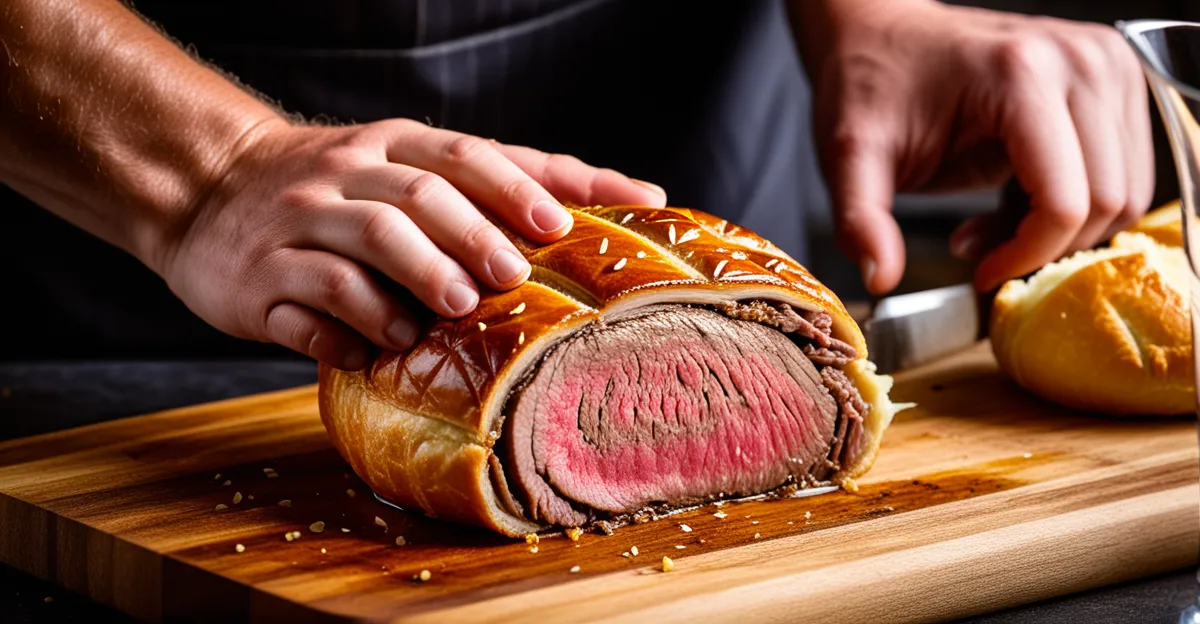Ingredients Required for Beef Wellington
Creating a Beef Wellington requires precision and attention to detail, particularly when selecting and preparing its essential components. At its core, this dish combines quality beef tenderloin, a flavorful mushroom duxelles, and a rich, buttery pastry.
Key Ingredients
-
Beef Tenderloin: The centerpiece of the Wellington, this cut is prized for its tenderness. Opt for a high-quality piece to ensure the best taste and texture.
Also to see : What are the tips for making a light and airy spotted dick?
-
Mushroom Duxelles: This mixture acts as a flavor base, enriching the dish with its earthy tones. Balanced flavors are key here, achieved through careful seasoning and preparation.
-
Puff Pastry: A well-executed pastry provides the Wellington’s signature crisp exterior. Store-bought or homemade, ensure it’s buttery and pliable.
Additional reading : What Are the Unique Characteristics of Traditional UK Dishes?
-
Prosciutto or Parma Ham: Used to wrap the beef and duxelles, adding a salty nuance that enhances the overall flavor profile.
Importance of Quality
The success of Beef Wellington hinges on the quality of its ingredients. Premium beef and buttery pastry ensure richness and depth. Fresh mushrooms contribute an authentic, earthy aroma that complements the dish’s decadent nature.
Optional Additions and Variations
For those seeking creative twists, consider adding foie gras for additional luxury or incorporating a herb-infused mustard layer to the beef. Alternatively, vegetarian variations might include hearty portobello mushrooms or root vegetables, maintaining the essence while catering to different dietary preferences. Exploring various substitutes and additions allows for personal flair, adding individuality to a classic recipe.
Preparing the Beef
The preparation of the beef is a crucial step in ensuring that your Beef Wellington stands out. Selecting the right cut of beef sets the foundation for a delightful culinary experience. The tenderloin is the preferred choice due to its exceptional tenderness and flavor, making it the apex of quality cuts for this dish.
Selecting and Seasoning
Proper seasoning techniques are essential to enhance the natural flavors of the cut. Start by generously seasoning the beef with a blend of salt, pepper, and any desired herbs to create a well-rounded taste. This allows the flavors to seep into the meat, ensuring every bite is flavorful.
Searing Techniques
Before assembling the Wellington, searing the beef is an important step that locks in juices. The searing beef process involves quickly cooking it on high heat until it develops a brown crust, which not only adds depth of flavor but also enhances its visual appeal. This searing ensures the beef remains tender and juicy once encased in pastry.
By thoroughly preparing the beef with care, from selecting it to skillfully seasoning and searing, you set the stage for a perfectly executed Beef Wellington that delights with every bite. Each step is vital in bringing out the subtleties of this classic dish, guaranteeing a rewarding culinary journey.
Making the Mushroom Duxelles
Creating the mushroom duxelles is a critical step in crafting a delicious Beef Wellington, as it serves as the flavorful foundation that elevates this classic dish. Understanding how to select, prepare, and season the mushrooms is essential for achieving the perfect flavor base.
Selecting and Preparing Mushrooms
Begin with fresh, high-quality mushrooms, as their texture and flavor significantly influence the final dish. Popular choices include cremini, shiitake, or portobello mushrooms for their rich, earthy taste. Clean the mushrooms effectively, gently brushing away any dirt without submerging them in water to retain their natural flavors.
Cooking Techniques for Texture
Achieving the right texture is all about the cooking method. Finely chop the mushrooms and sauté them over medium heat in a pan with a touch of oil or butter. Ensure you cook them until all the moisture evaporates, and the mixture becomes concentrated and slightly caramelized. This reduction intensifies the flavor and prevents the pastry from becoming soggy during assembly.
Seasoning and Balancing Flavors
Seasoning is key to enhancing the duxelles. Start with a pinch of salt and freshly ground black pepper, and consider adding aromatics like minced garlic or shallots for depth. Fresh herbs such as thyme or parsley can also be stirred in towards the end of cooking to brighten the flavors. Taste and adjust seasoning before allowing the mixture to cool fully before assembling the Wellington. By perfecting your mushroom duxelles, you create a robust flavor base that complements the tender beef and flaky pastry, resulting in a harmonious and satisfying Beef Wellington.
Assembling the Wellington
Creating a perfect Beef Wellington requires careful attention during the assembly phase, which is crucial for integrating flavors and maintaining texture. Begin by ensuring all your elements are prepared: the seasoned beef, mushroom duxelles, and pastry.
Layering and Moisture Management
To assemble your Wellington, begin by laying out the puff pastry on a flat surface. Spread an even layer of mushroom duxelles onto the pastry. It’s essential to manage moisture carefully at this step to prevent a soggy base. Wrap the seasoned and seared beef tenderloin snugly with prosciutto or Parma ham to create a barrier against moisture from the mushrooms. This layering strategy ensures each component retains its unique texture and flavor.
Securing the Pastry
Once layered, gently roll the pastry around the beef and fillings, ensuring tight wrapping to avoid leaking during baking. Seal the edges firmly, using a beaten egg wash if necessary, to secure the pastry. This step aids in achieving a crisp and clean presentation, resulting in a golden-brown crust that’s both visually appealing and structurally sound.
By focusing on these meticulous assembly techniques, your Beef Wellington will not only delight in flavor but also impress in its elegant presentation.
Cooking the Beef Wellington
Cooking a Beef Wellington demands precision to achieve its renowned delicate balance of textures and flavors. Knowing the right cooking methods, baking time, and temperature settings is crucial to ensure that your dish shines.
Recommended Cooking Temperatures for Different Doneness
To achieve your preferred level of doneness, precise temperature control is key. For a medium-rare finish, which is often recommended for maintaining the tenderness of the beef, aim to cook until the internal temperature reaches around 130°F (54°C). If you desire a medium doneness, let the temperature rise to 140°F (60°C). Always use a reliable meat thermometer for accuracy, as this will help you avoid overcooking.
Techniques for Achieving a Perfect Crust
The hallmark of a perfect Beef Wellington is its crisp, golden-brown crust. Start by preheating your oven to ensure consistent temperature distribution. Brushing the pastry with an egg wash before baking can enhance its sheen and contribute to a beautifully browned finish. Also, consider using a high-quality puff pastry, as its buttery composition aids in achieving that satisfying crunch.
Troubleshooting Common Cooking Issues
Even experienced cooks can encounter issues when cooking Beef Wellington. If you find the pastry becoming too dark before the beef is fully cooked, cover it lightly with aluminum foil to prevent further browning. Another frequent issue is a soggy base; to combat this, ensure the beef is well-sealed within the pastry and that you’ve adequately managed moisture during the assembly stage. By adhering to these methods, you can effectively troubleshoot and ensure your Wellington is impressive in both presentation and flavour.
Serving and Presentation Tips
Achieving an impressive presentation elevates your Beef Wellington from delicious to show-stopping. Consider these tips to enhance your final dish’s appearance and flavour.
Ideal Accompaniments and Side Dishes
Proper accompaniments can add balance and depth to your meal. Roasted vegetables like carrots or parsnips add a sweet contrast, while a creamy mashed potato provides a satisfying base. A simple red wine sauce or jus can complement and enhance the beef’s rich flavours.
Tips for Garnishing and Plating
Presentation matters in culinary arts. Sprinkle fresh herbs such as parsley over the top for a burst of colour. Use creative plating techniques, like layering components or adding a sauce drizzle for an enticing visual effect. Ensure each plate looks uniform to maintain elegance at the table.
Instructions for Carving Perfectly
Carving a Beef Wellington requires precision to preserve its structure. Allow it to rest for several minutes after baking to set the juices. Use a sharp knife to slice carefully, ensuring each piece retains its pastry layer, beef, and mushroom duxelles. Aim for uniform thickness so all guests enjoy an equal and delightful experience.
Troubleshooting Common Issues
Navigating potential hurdles in crafting a Beef Wellington can be daunting, yet understanding these common issues and their solutions can lead to triumph in the kitchen. This guide intends to equip you with the expertise to tackle pitfalls and elevate your Wellington to perfection.
Common Pitfalls and How to Avoid Them
Beginners often face the challenge of an undercooked or overcooked Wellington, which hinges on temperature control. Using a reliable meat thermometer is paramount in ensuring precise doneness. Missteps in pastry wrapping can lead to unpleasant results; ensuring a tight seal with minimal air pockets will prevent irregular baking and moisture seepage.
Remedies for Overcooked or Undercooked Wellington
If the meat overcooks, it is primarily a problem of insufficient temperature regulation or incorrect oven settings. Next time, verify the oven temperature, and reduce the cooking time. Conversely, should the beef be undercooked, return it to the oven in short intervals, checking frequently with a thermometer until the desired doneness is achieved.
Handling Issues with Pastry Texture and Flavor
Unwanted sogginess in the pastry suggests problematic moisture management during assembly. Prevent this by ensuring the pastry is adequately chilled before use, and remember to rest it after rolling to prevent shrinkage. For issues of flavor, consider revisiting your seasoning strategy or opt for high-quality pastry to enhance the buttery notes that elevate this dish.
By addressing these common issues with careful attention to detail and methodology, you can transform your culinary challenges into a deliciously rewarding Beef Wellington experience.
Variations on the Classic Recipe
Beef Wellington is a dish known for its elegance, but that doesn’t mean it can’t be adapted to personal tastes or dietary needs. Exploring different meats or vegetarian options can add a unique twist to this traditional fare.
Ingredient Substitutions for Dietary Preferences
Incorporating different meats or vegetarian options can cater to various palates and preferences. For those seeking alternatives to beef, options like pork or lamb can provide a similarly tender and flavorful experience, appealing to diverse culinary tastes. Vegetarians might enjoy Wellington versions featuring hearty portobello mushrooms or a medley of seasoned root vegetables to maintain the dish’s essence without the meat component.
Creative Twists on Traditional Preparation Methods
Adding a modern flair could involve altering the classic mushroom duxelles with a layer of herb-infused mustard or a touch of truffle oil for an elevated flavor. Consider experimenting with different beer or wine reductions as a part of the sauce to complement the Wellington’s rich elements. These creative choices allow for a personalized take on the iconic Beef Wellington, without losing the elegance and delight it traditionally offers.








